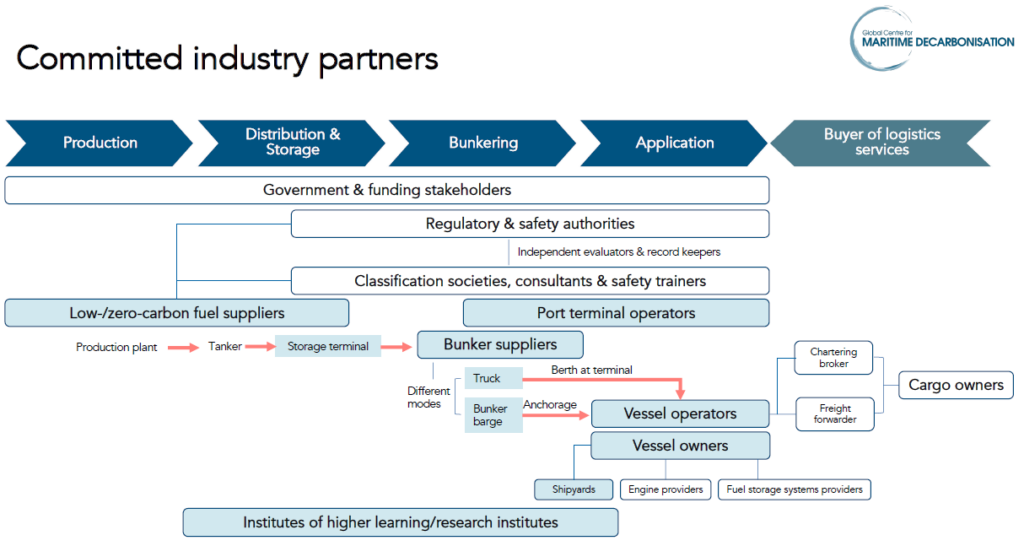GCMD & DNV: Pioneering Ammonia Bunkering Safety in Singapore
By Sofia Furstenberg Stott on June 17, 2022
On May 24th, the AEA hosted a Maritime Insights webinar which did a deep-dive into the Ammonia Bunkering Safety Study currently being undertaken in Singapore. The Study itself is run by the Global Center for Maritime Decarbonisation, with DNV Singapore acting as the Study Consultant, and with Surbana Jurong and Singapore Maritime Academy as additional partners.
This much-anticipated initiative brings a fundamental issue to the table: how do you ensure safe bunkering of ammonia in one of the busiest international ports in the world, and which also connects a bustling island nation of almost 6 million people?
GCMD

Lau Wei Jie, Director of Research and Projects at the GCMD, laid out a 5-year project outlook for the Center, involving biofuel pilots, shipboard carbon capture and wind-assist pilots, in addition to the ammonia bunkering safety study. The safety study (with its full title reading “Defining the safety + operations envelopes to enable ammonia bunkering pilot + demonstration”) is to be concluded around the end of year, where the next steps include proxy- and operational assets pilots up until 2026.
The core objective of this scope is to develop an extensive guideline like Technical Reference (TR 56) for LNG bunkering.
Lau Wei Jie, Director of Research and Projects at the GCMD, Ammonia Maritime Insights webinar 24 May 2022
[Author’s note: TR 56 was first launched in 2017 as the world’s first national standard to prepare Singapore’s bunkering industry to be ready for MARPOL Annex VI Global Sulphur limit of 0.5% which was introduced on 1 January 2020. It covers LNG delivery from LNG bunkering facilities to receiving ships through four modes of transfer.]
The safety study has a series of key deliverables:
- Identify and make recommendations to address regulatory gaps
- Recommend up to two sites for ammonia bunkering (in Singapore)
- Draft Technical Guidelines and Procedures
- Generate CAPEX models for ammonia bunkering infrastructure
- Develop competency standards for bunkering operations
- Validate and finalise findings with industry stakeholders
And gathers a wide range of stakeholders across the bunkering value chain,including fuel suppliers, port terminal operators, bunker suppliers, vessel owners, vessel operators, shipyards and R&D institutes. In the end, the project is expected to “support the establishment of a regulatory sandbox for pilots and demonstration projects”.

Utilizing the partnership with the Singapore Maritime Authority, the GCMD aims to use this project both to engage with global policy and regulatory platforms such as the IMO, Future Fuels Port Network and the Port Authorities Roundtable, as well as with the regional regulatory landscape.
DNV
DNV’s interest in the bunkering safety study is about “enabling ammonia as a maritime fuel, both safely and sustainably”, explains Dr. Imran Ibrahim, Principal Consultant and Head of Research and Development (DNV Maritime Advisory – Southeast Asia, Pacific-India). Beyond outcomes and partners, Dr. Ibrahim delved into the technical scope of the study.
The study will take four different bunkering modes into consideration:
- Ship-to-ship
- Shore-to-ship
- Truck-to-ship
- Cassette bunkering
And this is in line with TR56, which addresses the same four modes of bunkering. The under-development technical reference guideline will include four main pillars:
- Ammonia as a marine fuel – Safety and Regulations
- Custody transfer
- Bunkering and Safety Procedures
- Training and competency requirements

In addition to the development of such a guideline, the bunkering safety study will explore what quantities of fuel ammonia there will be demand for, and thus what volumes of ammonia storage Singapore should be planning for. This will further assist in the assessment of potential bunkering sites.
The project will also utilise results and key takeaways from other safety studies, in particular:
- External safety study – bunkering of alternative marine fuel for seagoing vessels (click to download pdf) – a study focused on the Port of Amsterdam, advising safety distances from the ammonia bunkering hose of 1.4 km (refrigerated) up to 2.6 km (pressurised).
- Ammonia Bunkering of Passenger Vessel – Concept Quantitative Risk Assessment (click to download pdf) – a study assessing risks from bunkering ammonia to fuel a passenger vessel in the Port of Oslo.

It was clear from audience Q&A that there is a desire to understand how such a study in Singapore can help progress ammonia bunkering elsewhere. But while concrete findings from the GCMD – DNV safety study are some time away, optimism is high. Dr. Ibrahim ended the session by quoting DNV’s CEO, Mr. Remi Eriksen, that “the fuel for the future is collaboration”. It captured the essence of this webinar perfectly.
The webinar was moderated by AEA’s Sofia Fürstenberg Stott, and can be accessed below. A pdf of the speaker presentations can be downloaded here.